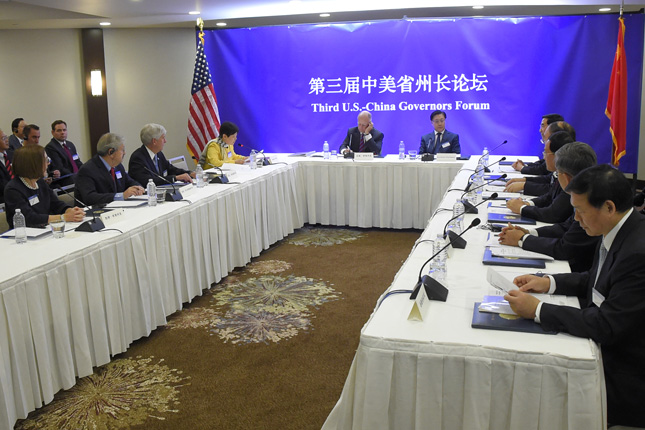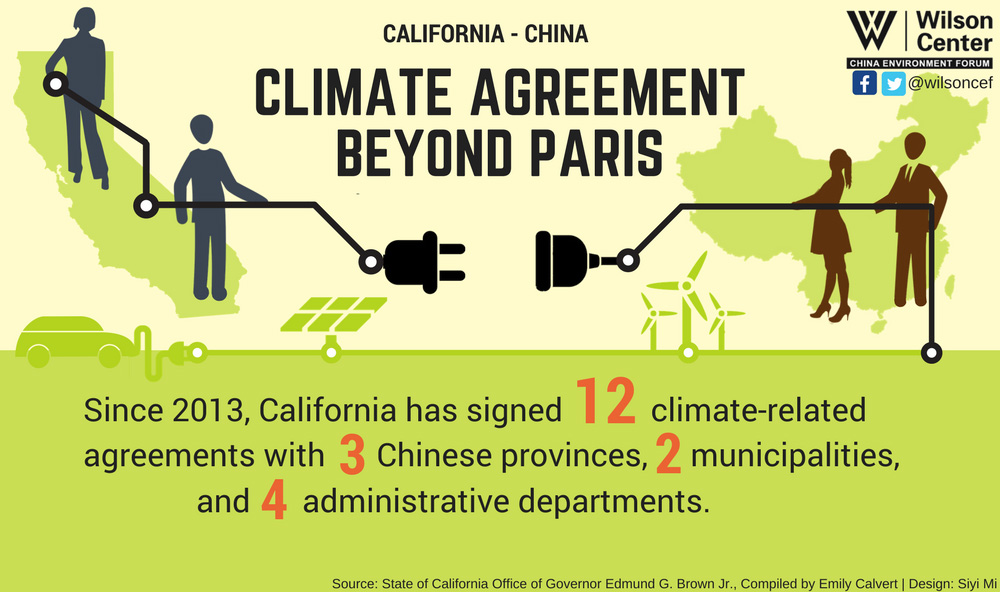-
Global Climate Cooperation, Post-Paris: Can Subnational Agreements Pick Up the Slack?
July 27, 2017 By Emily Calvert
At the G20 Summit in Hamburg early July 2017, leaders of the world’s strongest economies issued a joint statement reaffirming their commitment to the Paris Climate Accord. President Trump—the lone outsider—had announced in early June he would withdraw the United States from the agreement. As China doubles down on meeting its Paris targets, the chasm between the world’s two largest emitters and energy consumers continues to widen as previous joint efforts to curb carbon emissions fade away. Post-summit headlines focusing on the “G19” nations suggest America has abandoned international cooperation against climate change. But some U.S. cities and states are continuing the climate fight with their Chinese counterparts.
The Golden State is leading the charge. Five days after President Trump’s announcement, California Governor Jerry Brown met with Chinese President Xi Jinping in Beijing, signing a pledge to bolster a regional climate partnership between California and two Chinese provinces, as well as an agreement with China’s Ministry of Science and Technology to expand cooperation on green technologies. Both build upon a legacy of subnational Sino-American commitments that began in 2013.
But will such subnational collaboration make a difference without U.S. federal support? A survey of the agreements between California and various Chinese entities paints a tentatively optimistic picture.
Why Not National Cooperation?
U.S. mayors and governors have remained committed to the causeTrump’s federal government appears less willing to respond to the threats of climate change overseas and at home, but U.S. mayors and governors have remained committed to the cause. In China, despite Beijing’s commitment to reducing carbon intensity to 60 – 65 percent of 2005 levels by 2030, provincial and municipal officials often lack the infrastructure, experience, and motivation to enforce environmental policies that might compromise local economic growth.
In this context, California serves as an ideal model for Chinese provinces and municipalities. Once a state where vehicles and sprawling industrial facilities filled city skies with smog, California has since issued the nation’s strictest emissions standards under the guidance of the California Air Resource Board (CARB). Through various mitigation efforts, the state decreased its per capita greenhouse gas emissions by 20 percent while increasing its GDP by nearly 80 percent compared to 1990 levels. For California, China represents an emerging export market, an innovation incubator, and a wellspring of investment opportunities. These positive implications, along with a history of immigration and close cultural ties, led California to sign a memorandum of understanding with Guangdong, one of the most populous and wealthiest provinces in China.
California: A Foundation for Collaboration
In April 2013, during a trade and investment mission to China, Governor Brown met with top officials of Guangdong Province and announced two agreements. The first agreement placed emphasis on “enhancing the state-province friendship and mutual understanding” through cooperation in numerous areas: trade and investment, science and technology, environmental conservation, education, culture, and tourism. The second focused more exclusively on environmental collaboration, calling for scientific and economic collaboration through workshops, seminars, and expertise exchanges.
The Californian government also signed agreements with several Chinese ministerial departments, including the Ministry of Environmental Protection and the National Development and Reform Commission. The agreements established specific guidelines for issues ranging from technical and scientific exchange, to air quality management, to collaboration between Chinese and Californian entrepreneurs. While these ministries fall under the purview of Beijing, the fragmented nature of the Chinese central government means that ministries retain considerable autonomy. The ministries’ decisions to collaborate with the state of California were driven by the perceived benefits of working within the more manageable confines of subnational agreements.
That same year, California hosted six Chinese delegations, sent two American delegations to China, and exchanged four video conferences and multiple workshops with Chinese partners. Using lessons and experiences from California’s cap-and-trade scheme, China initiated seven provincial carbon emissions trading systems and designed its National Carbon Emissions Market, which will be launched in 2017.
In 2015, California renewed several agreements, making further contributions towards developing zero emission vehicles (ZEVs) through shared research and exchange. The state promoted its California-Guangdong model in Jiangsu Province, Zhenjiang Municipality, and the coastal city of Shenzhen.
2017: More Agreements, Positive Results
With the new agreements signed during Governor Brown’s June 2017 trip to Beijing, the two sides appear ready to embark on broader and deeper subnational collaboration, including:
- An expansion and update of the 2015 agreement with Jiangsu Province that continues cooperation on developing green technology and reducing emissions;
- A Clean Energy Pact with Sichuan Province that establishes the California-Sichuan Clean Tech Innovation Center;
- An agreement with the Ministry of Science and Technology focused on deepening cooperation on developing green technology;
- A joint initiative between California and Tsinghua University that establishes the U.S.-China Climate Change Institute, which intends to connect politicians, researchers, experts, and students and enhance cooperation at the subnational level.
The agreements signed last month indicate incremental yet steady progressMeasuring momentum on many novel, ambitious, and ongoing joint efforts is difficult, but the agreements signed last month indicate incremental yet steady progress. They represent long-term investments by California and China in curbing climate change, that build upon shared interests in improving energy efficiency, scaling up renewables, and advancing clean technologies. More and more partnerships are being forged between California and various Chinese entities, paving the way for fruitful collaboration well beyond Paris.
A Model for Other U.S. States in the Post-Paris Era?
The verdict is still out on whether subnational agreements can compensate for U.S. withdrawal from the Paris Climate Accord. Despite their enthusiasm, U.S. mayors, governors, and private entities lack critical federal support and enforcement of climate change mitigation measures. Meanwhile, Chinese provinces, municipalities, and ministries are burdened by the pressure of maintaining economic growth while coping with significant urban development challenges, such as water shortages, rising energy demands, and an ever-growing population.
But there are reasons to remain hopeful. The United States withdrawal from the main mechanism for international cooperation on climate change may have reinvigorated subnational actors. The successful and ongoing collaboration between California and China could provide a model for other states and cities vowing to uphold the U.S.’ Paris accord goals. By partnering with other countries—whether at the national or provincial level—U.S. states and cities could continue to move forward and perhaps even spur innovation that wouldn’t have been possible under the Paris agreement.
Emily Calvert is an MA candidate in the China Studies Program at Johns Hopkins School of Advanced International Studies in Washington, D.C.
Source: ABC News, Asia Society, California Energy Commission, California Environmental Protection Agency, Natural Resource Defense Council, New York Times, NPR, Office of Governor Edmund G. Brown Jr. of the State of California, Office of the Press Secretary of the White House, Scientific American, State of California, The Brookings Institution, The Guardian, The Press and Information Office of the Federal Government of Germany, The Washington Post, University of California Davis China Center for Energy and Transportation, USA Today, World Watch, Xinhua
Photo Credit: A bipartisan group of U.S. governors met and signed an accord with Chinese governors to promote clean energy technology and economic development, September 2015, courtesy of Governor Jay Inslee via the governor’s Flickr account.
 A Publication of the Stimson Center.
A Publication of the Stimson Center.




